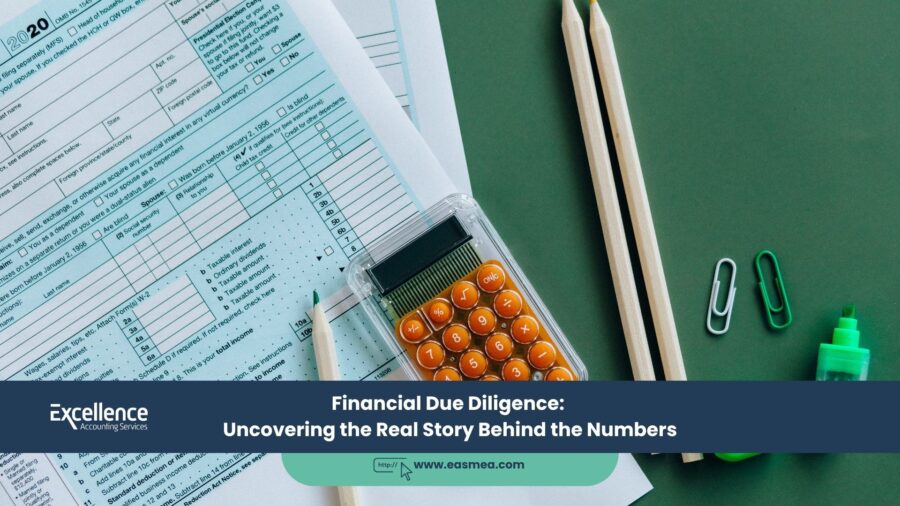Financial Due Diligence: Uncovering the Real Story Behind the Numbers
When considering an acquisition or a major investment in the UAE, the target company’s financial statements are the starting point of your analysis. The Profit & Loss statement shows a healthy profit, the balance sheet looks solid, and the growth trajectory appears impressive. But are you seeing the full picture? Financial statements, while essential, only tell part of the story. They report what has happened based on a set of accounting principles, but they don’t always reveal the underlying quality, sustainability, and risks of the business.
This is where Financial Due Diligence (FDD) becomes the most critical phase of any transaction. FDD is a forensic investigation that goes far beyond a standard audit. Its purpose is to scrutinize, validate, and adjust the financial data to reveal the true, underlying performance of the business. It’s the process of stress-testing the numbers to uncover hidden liabilities, unsustainable profits, and working capital risks that could derail an investment post-acquisition.
For any serious investor or corporate acquirer in the UAE, conducting thorough FDD is non-negotiable. It’s the difference between buying a business based on its polished exterior and buying it with a complete understanding of its engine room. This guide will take you deep into the world of FDD, explaining its core components, the critical questions it answers, and why it is the ultimate tool for making informed, intelligent investment decisions.
Key Takeaways
- FDD vs. Audit: An audit verifies that historical financial statements are free from material misstatement. FDD is an investigative process that analyzes the *quality* and *sustainability* of earnings for a transaction.
- Quality of Earnings (QoE) is Core: The primary goal of FDD is to determine a company’s true, recurring EBITDA by adjusting for non-recurring items, accounting choices, and other anomalies.
- Working Capital is Critical: FDD analyzes the target’s working capital needs to ensure the buyer doesn’t face a surprise cash crunch immediately after the deal closes.
- Uncover Hidden Liabilities: The process aims to identify all “debt-like” items and off-balance-sheet commitments that could impact the final purchase price.
- It Informs Valuation and Negotiation: The findings of an FDD report directly impact the business valuation and provide crucial leverage for negotiating the deal terms.
- Expertise is Paramount: FDD is a specialized field requiring experienced professionals. Partnering with a firm that provides expert due diligence services is essential.
The Core of FDD: The Quality of Earnings (QoE) Report
The centerpiece of any financial due diligence engagement is the Quality of Earnings, or “QoE,” analysis. Its objective is to calculate the most accurate and sustainable measure of a company’s profitability, typically its EBITDA (Earnings Before Interest, Taxes, Depreciation, and Amortization). This “normalized” or “adjusted” EBITDA becomes the basis for the company’s valuation.
The QoE process involves making a series of adjustments to the reported profit:
- Non-Recurring Revenue & Expenses: Stripping out one-off events that won’t repeat in the future. This could include profit from the sale of an asset, a large bad debt recovery, or significant legal fees from a one-time lawsuit.
- Owner-Related Expenses: Adjusting for costs that are not essential to business operations, such as above-market salaries for owners or personal expenses run through the company.
- Accounting Policy Adjustments: Analyzing the company’s accounting policies to see if they are too aggressive or conservative. For example, a company might be capitalizing expenses that should be expensed, artificially inflating its profit.
- Pro Forma Adjustments: Adjusting for known future changes. For example, if a major customer contract was lost just before the analysis, its revenue would be removed from the historical earnings to show a more realistic future baseline.
The QoE analysis bridges the gap between reported profit and true economic earnings. It provides the buyer with a reliable number to apply a valuation multiple to, ensuring they don’t overpay based on inflated or unsustainable profits.
Beyond Earnings: Other Critical Areas of FDD
While the QoE is central, a complete FDD investigation covers several other crucial areas.
1. Net Debt and Debt-Like Items Analysis
The team will perform a detailed analysis to identify all interest-bearing debt and other “debt-like” items that the buyer will effectively have to settle. This goes beyond just bank loans and can include:
- Unpaid taxes or outstanding Corporate Tax liabilities.
- Large, overdue payments to suppliers.
- Customer deposits that represent a future liability.
- Unfunded pension obligations or large end-of-service gratuity payments due to employees.
Identifying these items is crucial as they are typically deducted from the enterprise value to arrive at the final equity price.
2. Working Capital Analysis
This analysis is vital to ensure the business has enough cash to continue its normal operations after the transaction closes. The FDD team analyzes the historical levels of accounts receivable, inventory, and accounts payable to determine a “normal” level of working capital. If the actual working capital delivered at closing is below this normal level, the seller usually has to compensate the buyer for the shortfall via a purchase price adjustment.
3. Forecast and Synergy Analysis
The FDD team will rigorously scrutinize the management’s financial projections. They will assess the reasonableness of the assumptions behind the forecast, comparing them to historical performance and market trends identified in a feasibility study. If the buyer expects to realize “synergies” (cost savings or revenue enhancements from combining businesses), the FDD process will help validate whether these are realistic and achievable.
| FDD Component | Core Question Answered | Impact on the Deal |
|---|---|---|
| Quality of Earnings (QoE) | “What is the company’s true, sustainable profit?” | Directly determines the valuation and purchase price. |
| Net Debt Analysis | “What hidden liabilities will the buyer inherit?” | Increases the debt figure, reducing the final equity price. |
| Working Capital Analysis | “Will the business have enough cash to operate on Day 1?” | Protects the buyer from a post-deal cash crunch. |
| Forecast Review | “Are the management’s future projections believable?” | Validates the growth assumptions underpinning the valuation. |
Uncover the Truth with EAS Financial Due Diligence Services
A successful acquisition is built on a foundation of certainty. At Excellence Accounting Services (EAS), our dedicated transaction advisory team provides robust Financial Due Diligence services that empower you to make investment decisions with clarity and confidence.
Our FDD Services Include:
- Buy-Side and Sell-Side Due Diligence: We provide comprehensive FDD for both buyers seeking to validate a target and sellers preparing for a sale to ensure a smooth process.
- Quality of Earnings (QoE) Reports: Our core deliverable is a detailed QoE report that provides a clear and defensible calculation of normalized EBITDA.
- Working Capital and Net Debt Analysis: We conduct thorough analyses to protect you from value leakage and ensure the deal terms are fair.
- Integrated Approach: Our FDD work is seamlessly integrated with our business valuation and tax due diligence services to provide a holistic view of the transaction.
Frequently Asked Questions (FAQs)
They have fundamentally different objectives. An audit is a backward-looking exercise to provide an opinion on whether historical financial statements are free from material misstatement, according to accounting standards. FDD is a forward-looking, investigative process focused on a specific transaction. It aims to determine the sustainable earnings power, cash flow, and key risks for a potential buyer.
EBITDA stands for Earnings Before Interest, Taxes, Depreciation, and Amortization. It’s used as a proxy for a company’s operating cash flow and is the most common basis for valuation multiples in M&A. The primary goal of a QoE analysis is to calculate a reliable, “Adjusted EBITDA” that a buyer can confidently use to value the company.
It’s the average level of working capital (Current Assets – Current Liabilities, excluding cash and debt) that a business needs to operate smoothly throughout its normal business cycle. It’s often calculated as a 12-month average. This prevents sellers from manipulating the numbers by, for example, delaying payments to suppliers right before a sale to artificially boost their cash position.
Yes. “Failing” FDD typically means the investigation uncovers significant “red flags.” This could be evidence of fraudulent accounting, a business model that is fundamentally unprofitable without one-off gains, or massive hidden liabilities. More commonly, the FDD results in significant downward adjustments to the seller’s claimed profit, leading to a much lower valuation and potentially causing the deal to fall apart.
FDD is typically performed by a specialized team of transaction advisory professionals within an accounting or consulting firm. These are not regular auditors; they are specialists trained in forensic analysis and the nuances of M&A transactions.
Buy-side FDD is performed on behalf of the buyer to validate the target company. Sell-side FDD (also called vendor due diligence) is commissioned by the seller before they go to market. The goal is to identify and fix any issues proactively, which can speed up the sale process and help defend the asking price.
The findings directly influence the SPA. The adjusted EBITDA from the QoE report will be used to calculate the purchase price. The analysis of net debt and working capital will inform the specific price adjustment mechanisms written into the legal agreement. The FDD report also helps the buyer’s lawyers draft appropriate warranties and indemnities to protect against identified risks.
Common red flags include: aggressive revenue recognition policies; a high concentration of revenue from a single customer; a sudden, unexplained improvement in profit margins just before the sale process; inconsistent or poor-quality bookkeeping; and significant, undocumented transactions with related parties or owners.
While FDD focuses on earnings quality, a separate but related stream of work called Tax Due Diligence is usually performed alongside it. This focuses specifically on identifying historical tax exposures (e.g., unpaid VAT or incorrect Corporate Tax filings) that the buyer might inherit. Both are essential parts of a comprehensive due diligence process.
No. While essential for large M&A, FDD is just as critical for SMEs. For an SME buyer, making an acquisition is often a “bet the company” move, making it even more important to ensure there are no skeletons in the closet. The principles of uncovering the real story behind the numbers apply to transactions of all sizes.
Conclusion: Investing with Your Eyes Wide Open
In the world of investments and acquisitions, what you don’t know can, and often will, hurt you. Financial Due Diligence is the process of systematically turning the unknown into the known. It strips away accounting varnish and subjective claims to present a clear, objective, and reliable view of a company’s financial health. By uncovering the real story behind the numbers, FDD empowers you to negotiate a fair price, structure a secure deal, and make your next major investment with your eyes wide open.
Before You Buy, Verify.
Our expert Financial Due Diligence team provides the deep insights you need to invest with confidence.




